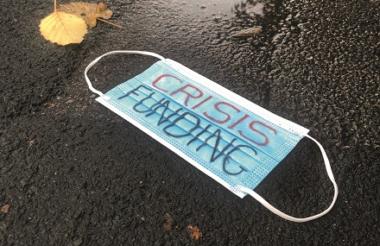Charities feel they have been treated shabbily by the government. Funding intended to support the sector through the pandemic was unattainable for many, and it came too late for those it did reach, in some cases so late that funding may actually have to be returned.
Moreover, the sector fears that the long-term consequences of the pandemic are poorly understood by a government that has put little effort into really listening to what charities have to say.
Charities are not alone in their concerns. Earlier this month, the Public Accounts Committee (PAC) strongly criticised the Department for Digital, Culture, Media and Sport for a lack of transparency about decision-making, deviation from formal processes and inadequate attention to impact.
However, MPs on the committee were largely concerned with whether proper processes had been followed, with much of the oral session devoted to questions about the involvement of special advisers. The written evidence submitted by charities raises some more fundamental questions about the government’s attitude to the sector.
Funding was not enough
The first point raised by charities is that the £750m support package, announced by the chancellor in spring 2020, was simply not enough to go around.
A joint submission by a coalition of infrastructure organisations (ACEVO, Charity Finance Group, Children England, Clinks, Directory of Social Change, Lloyds Bank Foundation for England & Wales, Locality, and NCVO) says this “would be a significant sum under any other circumstance”, but that “it fell substantially below the funding needed to meet growing needs in communities”.
This is echoed by others such as Women’s Aid, which says the domestic abuse and sexual violence sector got £37m from the emergency package, against an estimated need valued at £65m.
GMCVO, an umbrella body for charities in Greater Manchester, adds: “The total amount of funding that trickled down to small local charities was not nearly enough to fill the gap left by lost income.”
Excluding parts of the sector
Meanwhile, despite the package being billed as support for charities, in reality funding was only available to a narrow portion of the sector on the “frontline”.
Some sectors fell between the gaps. In its submission, the Association for Medical Research Charities (AMRC) says: “The overwhelming majority of medical research charities (97%) have not been able to access the government’s £750m support package or support for research-focused businesses.”
The British Heart Foundation adds that there were “no clear-cut mechanisms for medical research charities”.
Animal charities were in a similarly frustrating position. Blue Cross’s submission points out a “contradiction” between how different government departments classified its activity.
According to DCMS guidance, Blue Cross did not provide a frontline service supporting vulnerable people, so it could not benefit from the £750m. But key worker guidance stipulated that veterinarians, and its other staff, could continue to send their children to school.
The charity argues that “it would have been more consistent, and equitable, for DCMS to apply the same criteria as the rest of government”.
Opaqueness about departmental allocations is another complaint.
CLIC Sargent, now called Young People vs Cancer, says the Department for Health and Social Care announced which charities it was supporting without having any public application process. As a result the charity says it is “incredibly concerned at the lack of transparency”.
Another issue raised by Cancer52 is that the National Lottery Community Fund focuses on geographic communities, which was difficult for its members given that they are mainly small cancer charities which operate nationally.
“Future funding streams need to recognise that some charities support communities of people bound together by a common issue,” it says.
Distributing ‘at pace’
A consistent criticism from charities has been that this funding was distributed too slowly. But they also highlight that the windows to get applications in were tight and that once funds were received, they needed to be spent by 31 March.
The infrastructure coalition warns that “some funding risks being returned to HM Treasury” because charities are not able to spend the money before the deadline.
In some cases, charities say they have been given just six weeks to spend funds. ACEVO submitted an anonymous case study about a new charity that supports breastfeeding mothers, which had received a £2,000 grant on 12 February with a requirement to spend it by 31 March.
“As a small charity with no paid staff, this deadline created significant additional pressure, as the organisation had to replan projects and make quick decisions around insurance to ensure the funds could be spent in time,” it explains.
Meanwhile, large charities operating across the UK told MPs that the UK government was slower than its counterparts in Wales and Scotland.
BHF says: “The UK government took, on average, around four times as long to accept our application and administer the funds.”
‘Running out of steam’
Ultimately, the consequence of limited funding and delays to distributing what was there is that the charity sector is smaller and weaker than it was.
CLIC Sargent says it was unable to secure extra funding and that this contributed to two rounds of redundancies, reducing its workforce by 15%.
Meanwhile, Cats Protection reveals that it permanently closed 28 of its charity shops. It now has 104 shops and says the closures during 2020 and 2021 have “had a deep impact on our financial position”.
Many submissions tell MPs that charities are reducing services, or even closing altogether.
GMCVO warns: “We are now losing our local charities just when we need them most. Their heroic efforts are well known and acknowledged by our local politicians and communities, but they are now running out of steam.”
Others agree, and say that staff are working longer hours to try and plug the gaps.
Good Things Foundation, which works with a network of community hubs to build digital skills, writes in its submission: “Some centres attempted to offset the reduction in staff capacity by bringing in volunteers, but those that did highlighted the unsustainability of this situation. It was more common, therefore, for non-furloughed staff to keep working longer, unpaid hours to make up for the lost capacity.”
Problems with the furlough scheme are a recurrent theme throughout the submissions. While it has been a lifeline for some charities, others have been baffled by the government’s refusal to consider introducing some flexibility for charities where, unlike businesses, demand has soared.
Poorly understood
Charities also told PAC that the sector was poorly understood by ministers, particularly Treasury ministers.
Whether or not this stems from a hostile attitude borne out of ideological dislike of the sector, or a genuine lack of understanding, it was also accompanied by a familiar pattern of over-promising and under-delivering: promises were made which allowed charities to get their hopes up, only for government to backtrack, meaning that ultimately time and energy was wasted across the sector.
For example, Marie Curie says that, having received funding in support of its hospices, it “received an initial assurance that funding would not be offset against additional fundraising”. This assurance subsequently changed, but only after Marie Curie had put “significant effort into launching an emergency appeal”.
This meant that the more generous the public was, the less access Marie Curie had to government support, in a move that displays how poorly government understood charities’ financial models.
“Those who donated to Marie Curie’s emergency appeal, or who donated through other mechanisms, do not expect their donations to be used in the same month/quarter, however these donations were netted off against our expenses for that period in order to determine our ‘need’ for grant funding,” the submission explains.
BHF highlights another example. “In early November, the prime minister stated that the government would ‘be doing much more over the winter to support the voluntary sector’. This implied that another tailored support package may be forthcoming.”
No such fund materialised, and three months later the minister for civil society confirmed that nothing would be forthcoming.
The think tank Pro Bono Economics (PBE) asks in its submission why the government treated the charity sector differently from other parts of the economy, which received assistance more quickly and then saw adjustments to their support as the environment changed.
PBE also suggests that a “paternalistic approach” was taken by the government, which “appears to have hand-picked certain kinds of charitable causes to receive ring-fenced funds”.
Lessons for the future
Charities desperately hope that the government will acknowledge the long-term and lasting consequences of the pandemic, and finally listen to what the sector has been saying.
The Law Centres Network is one of the charities suggesting that its sector will “face another financial crisis” in the coming months. It urges the government to “learn from this experience and address the systemic weaknesses”.
The Directory of Social Change (DSC), meanwhile, identifies the relative weakness of the Office for Civil Society and its position as part of the Department for Digital, Culture, Media and Sport.
“Over the year it has become more and more apparent that government decision-making is mainly driven by HM Treasury, Number 10, the Cabinet Office and, to a degree, the Department for Health and Social Care,” its submission says.
DSC is also scathing about the Treasury’s attitude, saying it “does not understand the voluntary sector economy and generally appears not interested to learn”.
Overall, government rhetoric throughout the pandemic has been more positive about charities, as a sector, than at any time in other time in the past few years. But as these submissions to the PAC inquiry show, this is yet to have led to real understanding and action.
Related articles












